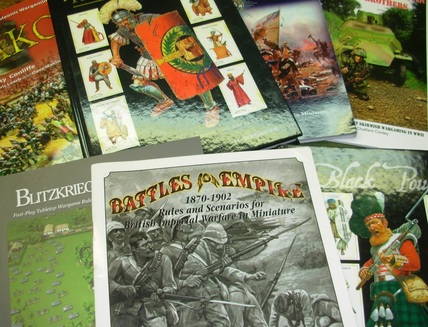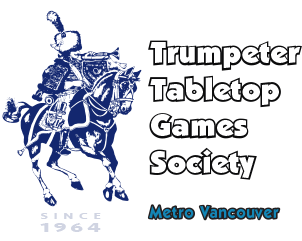What Is Wargaming?
Wargaming 101

Tabletop miniatures gaming - or wargaming - lets you play historical or fantasy battles on tabletops using miniature soldiers, vehicles and model terrain. It's a bit like combining chess or Risk with model railroading. Rules explain how your forces move, react and fight. This webpage will give you some basics on how these games work.
There are a variety of rule sets you can choose from that cover every historic period, science fiction or fantasy setting.
There are a variety of rule sets you can choose from that cover every historic period, science fiction or fantasy setting.
Choices – Rules and Historic options
Dozens of rule sets offer you tons of gaming options:
• Any historic setting from Ancients to Napoleonic to World War II to Modern
• Fantasy settings from Middle Earth to Outer Space to Steampunk
• Settings may be naval, air or land games
• Command forces in huge battles or exciting small-scale skirmishes
Check out some popular rule books at our Rules We Play section.
Units
Groups of models are organized in units representing squads or regiments
• In “skirmish” games one model represents one soldier
• In large-battle games 15 models can represent 600 soldiers
Commanding units
You move units on the model battlefield using measuring sticks or tapes.
• Cavalry, tanks or trucks move faster than foot soldiers
• Moving through forests or rivers can slow units
• Attack enemy forces when your units move close enough
Attacks
Your units "attack" enemy forces when they move into "range".
• Use dice to resolve shooting & hand-to-hand attacks
• Better units get better dice-odds for attacks
• Units in “cover” such as model houses or woods get better dice-odds for defence
• Each unit has a “range” for shooting – eg cannons shoot farther than rifles
• Successfully dicing “hits” on enemy units weakens or removes them
How do games end?
Gamers play contests based on actual battles or home-made scenarios.
• Each game has specific Victory Conditions
• Victory Conditions can range from destroying a portion of enemy units to capturing objectives
Scale & Size
Like model railroaders, gamers can pick from many "scales" or sizes of model armies.
• 15mm soldiers - about N-Scale in railroading - are affordable and let you use more figures on your tabletop
• 28mm soldiers - about 1-inch tall - can look impressive but can be pricey
• 20mm soldiers - about HO Scale - are also an affordable and popular choice
• Lots of other choices from 6mm to 40 and 54mm too
Gamers are inspired by:
• Strategy board games, chess, and risk
• Computer strategy games
• Interest in history
• Model building and figure painting
• Fantasy or Science Fiction or historic novels and movies
• Commanding great-looking miniature armies
Start by visiting a local club – such as our Trumpeter Society – to play a few games and discover the right rules and game style for you.
•
Need More Information?
Wargame clubs around the world offer sites that inspire and provide great information; here are a few:
The League of Augsburg: fantastic-looking armies
http://www.salute.co.uk: fun site from South London
Contact us
Have a question about the hobby or The Trumpeters society? Contact us at [email protected], join our Yahoo Group, or visit our society's Facebook page.
•
Also watch our club’s hobby video on Youtube below:
Dozens of rule sets offer you tons of gaming options:
• Any historic setting from Ancients to Napoleonic to World War II to Modern
• Fantasy settings from Middle Earth to Outer Space to Steampunk
• Settings may be naval, air or land games
• Command forces in huge battles or exciting small-scale skirmishes
Check out some popular rule books at our Rules We Play section.
Units
Groups of models are organized in units representing squads or regiments
• In “skirmish” games one model represents one soldier
• In large-battle games 15 models can represent 600 soldiers
Commanding units
You move units on the model battlefield using measuring sticks or tapes.
• Cavalry, tanks or trucks move faster than foot soldiers
• Moving through forests or rivers can slow units
• Attack enemy forces when your units move close enough
Attacks
Your units "attack" enemy forces when they move into "range".
• Use dice to resolve shooting & hand-to-hand attacks
• Better units get better dice-odds for attacks
• Units in “cover” such as model houses or woods get better dice-odds for defence
• Each unit has a “range” for shooting – eg cannons shoot farther than rifles
• Successfully dicing “hits” on enemy units weakens or removes them
How do games end?
Gamers play contests based on actual battles or home-made scenarios.
• Each game has specific Victory Conditions
• Victory Conditions can range from destroying a portion of enemy units to capturing objectives
Scale & Size
Like model railroaders, gamers can pick from many "scales" or sizes of model armies.
• 15mm soldiers - about N-Scale in railroading - are affordable and let you use more figures on your tabletop
• 28mm soldiers - about 1-inch tall - can look impressive but can be pricey
• 20mm soldiers - about HO Scale - are also an affordable and popular choice
• Lots of other choices from 6mm to 40 and 54mm too
Gamers are inspired by:
• Strategy board games, chess, and risk
• Computer strategy games
• Interest in history
• Model building and figure painting
• Fantasy or Science Fiction or historic novels and movies
• Commanding great-looking miniature armies
Start by visiting a local club – such as our Trumpeter Society – to play a few games and discover the right rules and game style for you.
•
Need More Information?
Wargame clubs around the world offer sites that inspire and provide great information; here are a few:
The League of Augsburg: fantastic-looking armies
http://www.salute.co.uk: fun site from South London
Contact us
Have a question about the hobby or The Trumpeters society? Contact us at [email protected], join our Yahoo Group, or visit our society's Facebook page.
•
Also watch our club’s hobby video on Youtube below:

